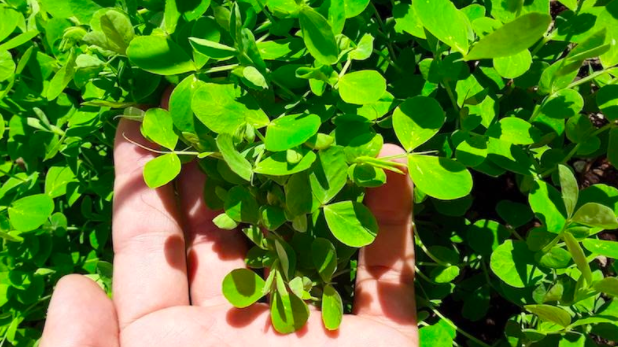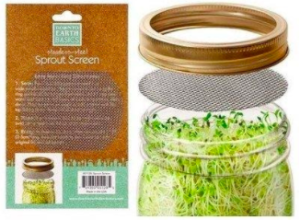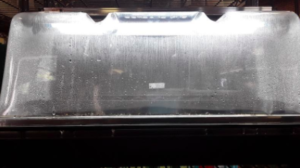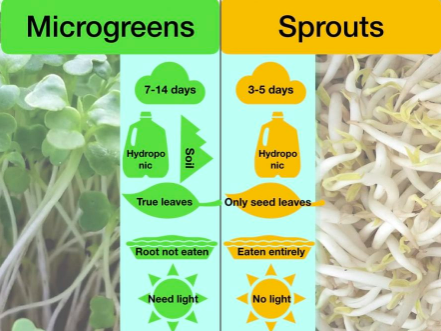
-Jonas Hall & Jess Pusch-
As we move from summer into fall and our gardens shift to cold-loving crop varieties, we can see the end of the outdoor growing season on the horizon. Gearing up for final harvests as late as November, we’ll have fewer fresh vegetables to eat than we enjoyed during the summer, but we can still enjoy fresh sprouts and microgreens grown indoors!
What are sprouts?
Your familiarity with sprouts might be limited to their use in stir frys (mung bean sprouts) and as a sandwich topping (alfalfa sprouts), but they’re also great on their own. Sprouts are simply the result of a seed that has germinated – the seeds themselves are hard to digest, “sprouting” them makes their nutrients readily available to humans. They are typically consumed as an entire plant (root, seed, and shoot), unlike microgreens, which are cut off at soil level and harvested for the leaves only.
It typically takes 3-5 days for sprouts to become fully grown. Sprouted beans are more nutritious than cooked dry beans thanks to their raw edibility after hydration and germination. A general rule of thumb is that if you can eat the greens or root of the seed, you can eat the sprouts. It should be noted that sprouts of the solanaceae family (also known as nightshades – tomato, potato, paprika, and eggplant) can be poisonous and should not be eaten.

Sprouts are often grown hydroponically, without soil, and generally do not need light to germinate. A popular way to produce sprouts is to use a mason jar with a draining lid. This allows you to easily rinse and drain your sprouts, 3-4 times a day, until they are ready to eat. Once ready, sprouts can be eaten fresh, cooked, or patted dry and stored in the refrigerator for up to a week.
Fifth Season offers a variety of sprouting seeds, supplies, and kits from Masontops and Sow True Seed for folks interested in fresh sprouts this fall and winter.
What are microgreens?
Microgreens are a great way to grow cost-effective fresh greens indoors, especially in the winter, or for gardeners that have limited time or space. They are nutrient-dense and full of flavor.
Microgreens have three basic parts: a central stem, cotyledon leaves (the first leaves to emerge from germination), and the first true leaves. Microgreens are harvested at the first true leaf stage. They vary in height depending on the seed, with the typical size being 1 to 1.5 in (25 to 38 mm) in total length. The average crop-time for fast-growing microgreens, such as many brassicas, is 10-14 days from seeding to harvest. Slower growing microgreens, such as beets, chard, and many herbs may take 16-25 days to reach harvestable size. Both baby greens and microgreens are marketing terms used to describe their respective categories.

A common way of growing microgreens indoors includes planting seeds into a high quality seed starting mix in a nursery tray and covering them with a humidome. Seeds can be soaked overnight, then sowed directly into the soil (following seed-specific planting directions). It is best to sow seeds thickly in the growing medium, and to organize seeds with similar growth rates into the same trays.
Fifth Season carries multiple kinds of nursery trays, humidomes, grow lamps, soil mixes, and many of the seed varieties often used for microgreens. Fifth Season also offers the SunBlaster: Nanodome Mini Greenhouse Kit, which includes the tray, humidome, and grow lamp in one easy package.
What varieties should I grow?
The most popular seeds used to grow sprouts are alfalfa, broccoli, fenugreek, red clover, lentil, mung bean, pumpkin, sunflower, and chia.

The easiest plants to grow as microgreens include arugula, pak choi, broccoli, buckwheat, cabbage, cauliflower, chia, and kale. Intermediate microgreens are coriander, dill, leek, peas, spinach, and sorrel. Seeds that are considered more challenging to grow as microgreens include basil, beets, chard, and cilantro.
What do I need to get started?
Growing sprouts indoors requires very little. The most common materials used to grow sprouts include a 1 quart mason jar and a plastic sifting screen. Fifth season offers a variety of sprouting seeds, supplies, and kits from Masontops and Sow True Seed. The Sow True Seed: Organic Sprouting Seed Kit includes a mix of seeds, a 1 quart mason jar, a plastic sifting screen, and instructions.
Basic Steps:
- Soak the seeds overnight
- Drain the water and rinse the seeds
- Angle the jar to allow water to drip out and air to circulate
- Rinse and drain the seeds 3 to 4 times a day until they have reached 1-2 inches
- While growing, keep the jar at room temperature and out of direct sunlight
- Once sprouts have reached 1-2 inches, submerge them in a large bowl of cool water to remove hulls. Enjoy!
To grow organic microgreens indoors, all you will need is a 10”x20” format nursery tray, humidome, growing media, and seeds to get started. The trays can be placed in a sunny spot by a window, however, they will grow faster with a grow lamp. The SunBlaster: Nanodome Mini Greenhouse makes starting microgreens even easier, with the grow lamp, reflector, tray and humidome already included.
Basic Steps:
- Read the seed packet for any specific instructions
- Fill the container with a couple inches of moist seed-starting soil
- Spread the seeds in a thick matt
- Cover the seeds with a thin layer of soil and dampen
- Place humidome over the tray, leaving the tray in direct sunlight or under a grow lamp
- Keep soil moist but not wet
- When seeds have sprouted, remove the cover and continue to keep the soil moist
- Once microgreens have reached the desired length, use scissors to cut them at the soil level and enjoy!


Marty Roddy says
Thanks, I have been eating sprouts for years But want tyo start some microgreens too. Thank for the info, See you at the store.
Knowledge Sourcing says
Microgreens are rich in vitamins and nutrients and exhibit a significant amount of antioxidant properties in their more developed types.
Sophia says
Are the microgreen seeds from Allthatgrows chemical free? Hope they are not treated with thiram.
ashley says
Hi Sophia, I don’t know Allthatgrows, but our sprouting seeds from Sow True Seed are certified organic.
Sophia says
I read this article completely it’s very useful for me I learned so many things about Microgreens. Thanks for your detailed information:-)